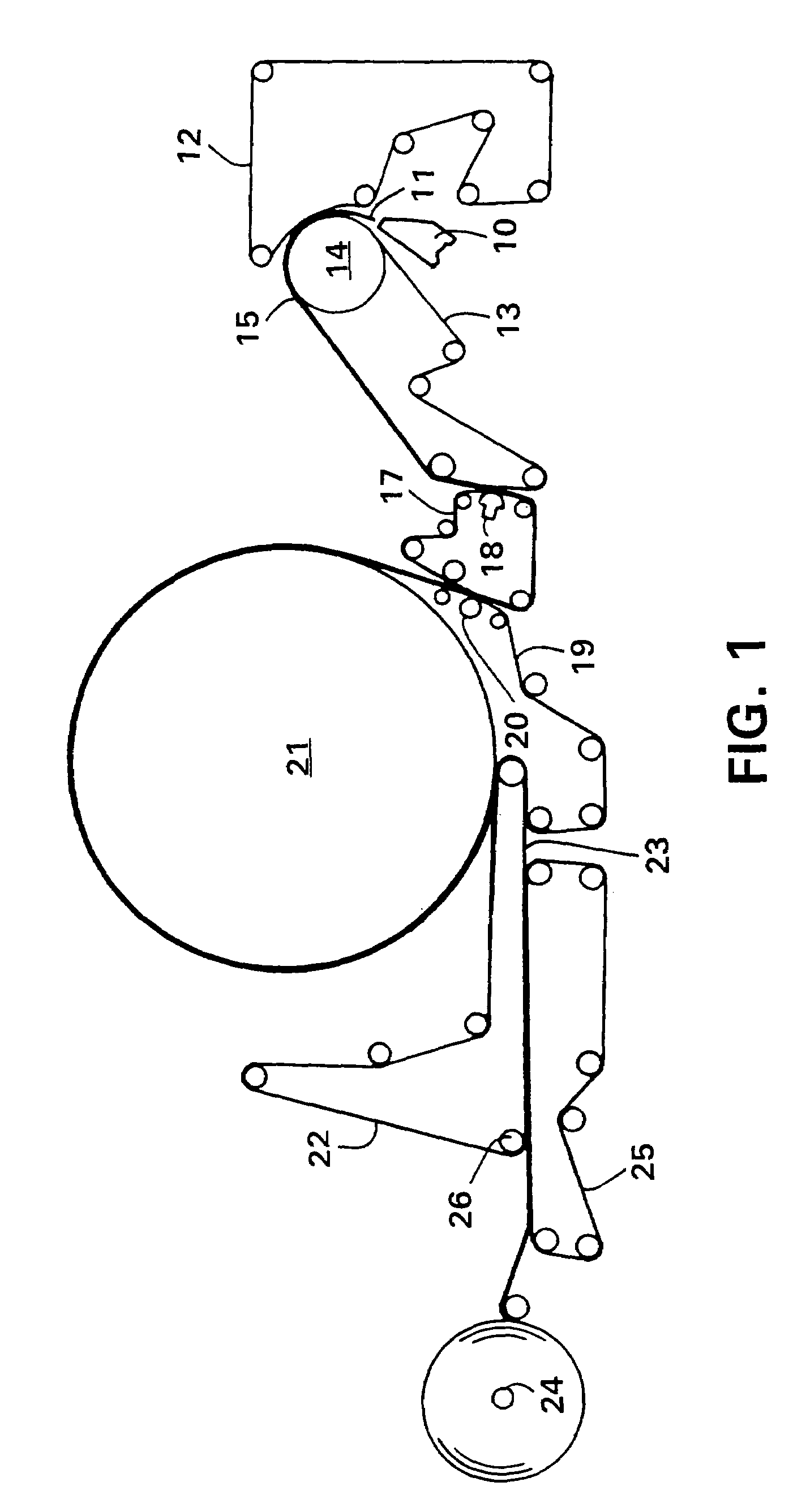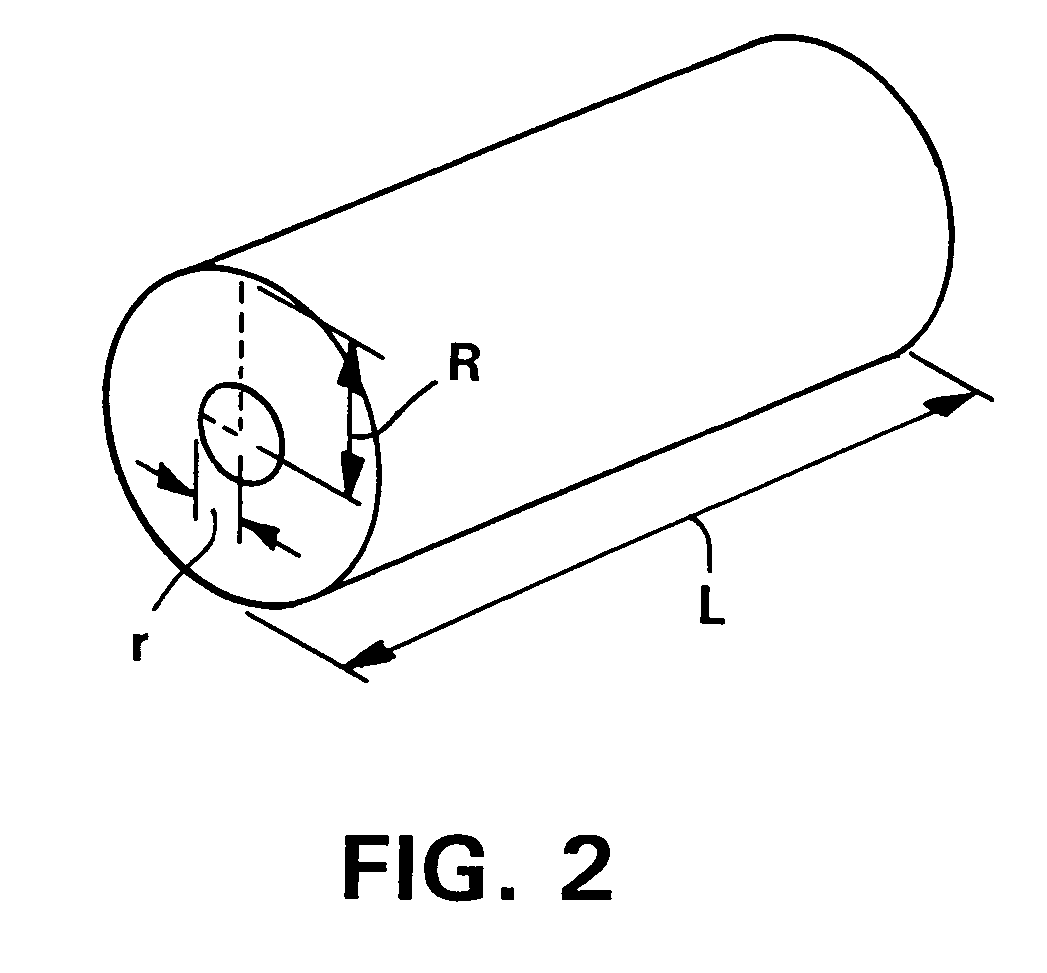Method for making rolls of tissue sheets having improved properties
a tissue sheet and improved technology, applied in the direction of patterned paper, press section, non-fibrous pulp addition, etc., can solve the problem of not showing exceptional roll bulk befitting, and achieve the effect of improving bulk/firmness properties of tissue sheet rolls, including throughdried tissue sheets, and high degree of bulk and firmness
- Summary
- Abstract
- Description
- Claims
- Application Information
AI Technical Summary
Benefits of technology
Problems solved by technology
Method used
Image
Examples
example 1
[0069]An uncreped throughdried tissue sheet was made in accordance with this invention as described above in connection with FIG. 1. More specifically, a non-layered single ply towel tissue was made using a furnish comprising 50 dry weight percent northern softwood kraft fiber (NSWK), 25% northern softwood bleached chemi-thermomechanical fiber (BCTMP), and 25% southern hardwood kraft fiber (SHWK).
[0070]The NSWK fiber was pulped for 30 minutes at approximately 4 percent consistency and diluted to approximately 3.2 percent after pulping. The BCTMP and SHWK fibers were combined together in a 50:50 ratio and pulped for 30 minutes at approximately 4 percent consistency and diluted to approximately 3.2 percent after pulping. Kymene 557LX was added to both pulp streams at 10 kilograms per metric ton of pulp based on total flow. The NSWK fibers were refined at 1.0 horsepower-day (0.75 kW days) per metric ton. The pulp streams were then blended and diluted to approximately 0.18% consistency....
example 2
[0073]A single ply towel was made as described in Example 1 except the furnish consisted of 50 percent NSWK, 25% BCTMP, and 25% northern hardwood kraft fiber (NHWK), the NSWK was refined at 1.5 horsepower-days (1.1 kW) per metric ton, the throughdrying fabric was an Appleton Mills t1205-2 fabric, and the resulting basesheet was calendered at a fixed gap of 0.007 inch (0.178 millimeter).
[0074]The resulting finished product had the following properties: basis weight, 22.4 pounds per 2880 square feet (38.1 grams per square meter); MD tensile, 2540 grams per 3 inches (76.2 millimeters) sample width; CD tensile, 1680 grams per 3 inches (76.2 millimeters) sample width; MD stretch, 18.7 percent; CD stretch 10.3 percent; MD slope, 5.43 kilograms per 3 inches (76.2 millimeters) sample width; CD slope, 6.36 kilograms per 3 inches (76.2 millimeters) sample width; geometric mean stiffness, 2.84; single sheet caliper, 0.034 inch (0.86 mm); roll bulk, 17.1 cubic centimeters per gram; roll firmnes...
example 3
[0075]A single ply towel was made as described in Example 2 except the transfer fabric was an Appleton Mills t1605-2 fabric and the throughdrying fabric was an Appleton Mills t1205-2 off-seamed fabric at a finished offset angle of 0.273 degrees.
[0076]The resulting finished product had the following properties: basis weight, 21.8 pounds per 2880 square feet (37.1 grams per square meter); MD tensile, 2130 grams per 3 inches (76.2 millimeters) sample width; CD tensile, 1970 grams per 3 inches (76.2 millimeters) sample width; MD stretch, 17.5 percent; CD stretch 13.0 percent; MD slope, 9.13 kilograms per 3 inches (76.2 millimeters) sample width; CD slope, 5.06 kilograms per 3 inches (76.2 millimeters) sample width; geometric mean stiffness, 3.31; single sheet caliper, 0.034 (0.86 mm); roll bulk, 19.4 cubic centimeters per gram; roll firmness, 5.85 millimeters; roll bulk divided by roll firmness, 33.2 square centimeters per gram; roll bulk divided by roll firmness divided by single sheet...
PUM
| Property | Measurement | Unit |
|---|---|---|
| angle | aaaaa | aaaaa |
| angle | aaaaa | aaaaa |
| angle | aaaaa | aaaaa |
Abstract
Description
Claims
Application Information
 Login to View More
Login to View More - R&D
- Intellectual Property
- Life Sciences
- Materials
- Tech Scout
- Unparalleled Data Quality
- Higher Quality Content
- 60% Fewer Hallucinations
Browse by: Latest US Patents, China's latest patents, Technical Efficacy Thesaurus, Application Domain, Technology Topic, Popular Technical Reports.
© 2025 PatSnap. All rights reserved.Legal|Privacy policy|Modern Slavery Act Transparency Statement|Sitemap|About US| Contact US: help@patsnap.com



